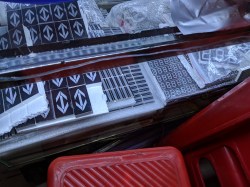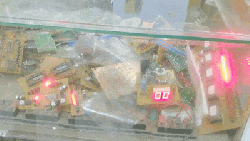Sunday, March 31
Build Your Own Metal Roller
Metal fabrication is a useful skill to have. There’s plenty you can achieve in your workshop at home, given the right tools. There’s lathes for turning, mills for milling, and bandsaws and dropsaws for chopping it all to pieces. But what do you do if you need to make hoops and bends and round sections? You build a metal roller, of course – and that’s precisely what [James Bruton] did.
The main body of the tool is built out of box section, chosen largely as it’s what [James] had lying around. Bearings are of the familiar pillow block variety, with 20 mm bright steel serving as the rollers due to its better tolerance than mild steel stock. Set screws hold the shafts in place to avoid everything sliding around the place. A 10-ton bottle jack then provides the force to gently bend the workpiece as it passes through the rollers.
Initial tests were positive, with the roller producing smooth curves in 4 mm thick steel bar. There were some issues with runout, which were easily fixed with some attention to the parallelism of the shafts. It’s a tidy build, and can serve as a basis for further upgrades in future if necessary.
We’ve seen DIY roll benders before, too. Video after the break.
A Weather Station Fit For A PDP-11
The Digital Equipment Corp. PDP-11/70 is a masterpiece of Cold War-era industrial design. This microcomputer was the size of one or two modern server racks depending on configuration, and the front panel, loaded up with blinkenlights, was clad in a beautiful rose and magenta color scheme. The switches — the ones you used to toggle bits in memory — were actually custom designed covers made to match the shape of the completely unnecessary bezel. The aesthetic of the 11/70 is the intersection of baroque and modernism on the design Venn diagram.
[Oscar Vermeulen] built a miniature version of the PDP-11/70 that houses a Raspberry Pi, and [rricharz] has been hard at work bringing an original copy of BSD to this system. The first great project to come out of this effort? It’s a weather station, and it’s exactly as cool as you think it is.
A bit of ground work went into this build, including getting a historical Unix system up and running, in this case 2.11 BSD. Armed with a Pi and the PiDP-11/70 front panel, [rricharz] had a complete BSD system up and running, and with cool-retro-term, the interface looked the part. Doing something useful was another question entirely, but the Pi in the PiDP had some GPIOs free, so this ancient machine got an I2C temperature and pressure sensor.
The completed build is basically just a breadboard, a tiny diagnostic OLED, and a python script that grabs the data and sends it over to the sim. This is pressure and temperature data shoved into an emulation of a Tektronix 4010 terminal. It’s marginally useful work done by an ancient BSD system wrapped in an emulation on a Raspberry Pi. It doesn’t get better than that.
Squeezebox Comes To The ESP
Streaming music may now come from somewhere in the cloud to an app on your phone and be sent to the client built in to almost every entertainment device you own, but there was a time when the bleeding edge lay in dedicated streaming device that connected to your existing set-up. One of the players in this market was Logitech with their Squeezebox line of products, and while the original hardware may have been discontinued it remains very much alive among its dedicated userbase due to the free nature of the Logitech Media Server software and implementations of the slimproto streaming protocol in players. Now you can create a network player on about as cheap hardware as it is possible to find, because [Bgiraut] has produced a client for the ESP32 and ESP8266.
The software can be found on GitHub, and comes with the warning that it’s an early proof-of-concept rather than a polished release. It has two options for playback that both require a little bit of extra hardware, an I2S DAC for uncompressed streams or a VS1053 codec module for compressed ones, but neither of those need be expensive.
You can find Logitech Media Server from its download page, and give this device a try. Meanwhile we’ve covered many Squeezebox implementations, including ones on the Raspberry Pi, and the PogoPlug.
Thanks [joyofdivisions] for the tip.
ROS Gets Quick Sensor Debugging In The Terminal
Sensors are critical in robotics. A robot relies on its sensor package to perform its programmed duties. If sensors are damaged or non-functional, the robot can perform unpredictably, or even fail entirely. [Dheera Venkatraman] has been working to make debugging sensor issues easier with the rosshow package for Robot Operating System.
Normally, if you want to be certain a camera feed is working on a robot, normally you’d have to connect a monitor and other peripherals, check manually, then put everything away again when you’re finished. [Dheera] considered this was altogether too much of a pain for basic sensor checks.
Instead, rosshow uses the power of SSH to speed things along. Log in to the robot, fire off a few command line instructions, and rosshow will start displaying sensor data in the terminal on your remote machine. It’s achieved through the use of Unicode Braille art in the terminal. Sure, you won’t get a full-resolution feed from your high-definition camera, and the display from the laser scanner isn’t exactly perfect. But it’s enough to provide an instant verification that sensors are connected and working, and will speed up those routine is-it-connected checks by an order of magnitude.
Robot Operating System is a particularly useful platform if you’re thinking about the software platform for your next build. If you do put something together, be sure to let us know.
Ikea Furniture Hacks Make Accessibility More Accessible
The ThisAbles project is a series of 3D-printed IKEA furniture hacks making life easier for those without full use of their bodies. Since IKEA furniture is affordable and available across most of the planet, it’s the ideal target for a project that aims to make 3D-printed improvements accessible to everyone.
These hacks fit all meanings of the word “accessible”: Available worldwide, affordable, and helping people overcome physical barriers of everyday living. ThisAbles has support of multiple organizations including IKEA Israel. In their short introductory video (embedded below the break) they explained their process to find ways to make big impacts with simple 3D-printed modifications. From bumpers protecting furniture against wheelchair damage, to handles that allow drawers to be opened without fine fingertip control. Each of these designs also fit the well-known IKEA aesthetic, including their IKEA style illustrated manuals.
The site launched with thirteen downloadable solutions, but they have ambitions for more with user feedback. There’s a form where people can submit problems they would like to see solved, or alternatively, people can submit solutions they’ve already created and wish to share with the world. Making small changes to commodity IKEA furniture, these 3D printed accessories will have far more impact on people’s lives than the average figurine trinket on Thingiverse. It’s just the latest way we can apply hacker ingenuity to help others to do everything from simple daily tasks to video gaming.
[via Washington Post]
Bidirectional IP with New Packet Radio
There are a few options if you want to network computers on amateur radio. There are WiFi hacks of sort, and of course there’s always packet radio. New Packet Radio, a project from [f4hdk] that’s now on hackaday.io, is unlike anything we’ve seen before. It’s a modem that’s ready to go, uses standard 433 ISM band chips, should only cost $80 to build, and it supports bidirectional IP traffic.
The introductory documentation for this project (PDF) lays out the use case, protocol, and hardware for NPR. It’s based on chips designed for the 433MHz ISM band, specifically the SI4463 ISM band radio from Silicon Labs. Off the shelf amplifiers are used, and the rest of the modem consists of an Mbed Nucleo and a Wiznet W5500 Ethernet module. There is one single modem type for masters and clients. The network is designed so that a master serves as a bridge between Hamnet, a high-speed mesh network that can connect to the wider Internet. This master connects to up to seven clients simultaneously. Alternatively, there is a point-to-point configuration that allows two clients to connect to each other at about 200 kbps.
Being a 434 MHz device, this just isn’t going to fly in the US, but the relevant chip will work with the 915 MHz ISM band. This is a great solution to IP over radio, and like a number of popular amateur radio projects, it started with the hardware hackers first.
DNA Computers are in the Lab Now
Although it isn’t very real-world practical, researchers at Cal Tech have produced a DNA-based programmable computer. Spectrum reports that the system executes programs using a set of instructions written in DNA using six bits. Like any programmable computer, this one can execute many programs, but so far they run 21 different programs.
Using DNA for computation isn’t new — your body does it all the time. But, in general, DNA computers were akin to some logic gates that would do one set of things, not a general-purpose reprogrammable computer.
DNA has two parts composed of four different chemicals — you can think of each part as a ladder cut vertically down the middle with each “rung” being one of the four chemicals. Each part will try to pair up with a part that has a complementary set of rungs. The researchers created DNA strands to act like logic gates that have two inputs and two outputs. They combine five of these gates to create a layer with six inputs and six outputs. A program contains a stack of these six-bit layers.
The computer’s complete set of instructions uses 355 different types of components known as tiles. Each one uses multiple DNA strands for redundancy which helps combat errors. Despite this, the error rate is still relatively high compared to an electronic computer. The team reports they have programs that do copying, sorting, recognizing palindromes and multiples of three, random walking, obtaining an unbiased choice from a biased random source, electing a leader, simulating cellular automata, generating deterministic and randomized patterns, and counting to 63. The overall per tile error rate of less than 1 in 3,000.
A custom compiler takes input and produces the information required to “run” the DNA computer. The compiler produces a list of DNA sequences to add, when to add them, and at what temperature. It takes about a day for a program to complete, so this isn’t going to power the next wave of supercomputers.
It takes one or two hours for the DNA origami nanotube to grow and another day or so for the computation to complete. However, it does have possible applications for creating self-assembling programmable matter.
Maybe its time to start getting some DNA lab gear built. Maybe you can watch a movie on some bacteria during your breaks.
Zachary Quinto feeds off the souls of children in first trailer for NOS4A2
A soul-sucking vampire preys on young children in AMC's new supernatural horror series, NOS4A2.
Zachary Quinto plays a soul-sucking vampire who preys on children and traps them in an alternate dimension where it's always Christmas in the new AMC series NOS4A2 (pronounced "Nosferatu," after the classic 1922 vampire film). The series is an adaption of the 2013 award-winning horror novel of the same name by Joe Hill, and the first trailer just debuted earlier today at WonderCon in Anaheim.
(Some spoilers for the book below.)
Hill comes by his horror chops naturally; his dad is an obscure novelist named Stephen King. NOS4A2 is Hill's third novel, about a woman named Vic McQueen with a gift for finding lost things, who discovers that children have been disappearing. The culprit is a supernatural child abductor named Charles Manx, who hunts for his victims in a 1938 Rolls-Royce dubbed the "Wraith." He feeds off their souls in order to remain immortal, trapping whatever is left of them in a prison dimension in his imagination called Christmasland. The novel moves back and forth between multiple time periods: Vic as a young girl in 1986, Vic as a rebellious teenager in 1996, and an older Vic with a son in 2008 and 2012. Naturally Manx targets her son, and Vic must defeat him once and for all to save the boy.
Saturday, March 30
Grab an Image From Your O-scope The Easy Way
The Rigol DS1054Zed is the oscilloscope you want. If you don’t have an oscilloscope, this is the scope that has the power and features you need, it’s cheap, and the people who do hardware hacks already have one. That means there’s a wealth of hardware hacks for this oscilloscope. One small problem with the ‘Zed is the fact that capturing an image from the screen is overly complicated, and the official documentation requires dedicated software and a lot of rigolmarole. Now there’s a simple python script that grabs a screen cap from a Rigol scope.
The usage of this python script is as simple as plugging the DS1054Z into your USB port and running the script. A PNG of whatever is on the screen then appears on your drive. Testing has been done on OS X, and it probably works on Linux and Windows. It’s a simple tool that does one job, glory and hallelujah, people are still designing tools this way.
This work was inspired by the efforts of [cibomahto], who spent some time controlling the Rigol with Linux and Python. This work will plot whatever is being captured by the scope in a window, in Linux, but sometimes you just need a screencap of whatever is on the scope; that’s why there were weird Polaroid adapters for HP scopes in the day.
Yes, it’s a simple tool that does one job, but if you need that tool, you really need that tool. [rdpoor] is looking for a few people to test it out, and of course pull requests are accepted.
Hash and Roll Your Way To Secure Passwords
In the electronic battlefield that is 2019, the realm of password security is fraught with dangers. Websites from companies big and small leak like sieves, storing user data in completely unsecure ways. Just about the worst thing you can do is use the same password across several services, meaning that an attack on one gives entry to multiple accounts. The challenge is to generate a unique and secure password for each and every application, and [Ilia]’s way of doing that is called HashDice.
No, it’s not a password manager, or an app – it’s a simple method that can be readily applied by anyone with the right tools. A simple dice is used to create random numbers, which are used to select words from a list to form the basic secret phrase. This is then combined with the name of the service or application to be accessed, the date, and a salt, before hashing using the SHA256 algorithm. The final hash is then truncated to create the password. You can do it all on a device that’s airgapped from the world, ensuring your core secret is never exposed, thus maintaining security.
There are some pitfalls to this method, of course. Many websites make things harder by requiring special characters or enforcing length limits on passwords. [Ilia] helpfully suggests several workarounds for this, but admits that no system is perfect in the face of these obstacles.
If you’re now wondering if your current password is safe, there are ways to investigate that, too.
A Pet Robot, Just Like Boston Dynamics Makes
Every few months or so, a new video from Boston Dynamics will make the rounds on the Internet. This is their advertising, because unless the military starts buying mechanical mules, Boston Dynamics is going to be out of business pretty soon. You’ll see robots being kicked down the stairs, robots walking through doors, and robots acting like dogs. If a hundred or so highly skilled and highly educated roboticists, technologists, and other experts can put together a walking dog robot in a decade, obviously one person can cut through the cruft and build one in a basement. That’s what [Misha] is doing. It’s the Dizzy Wolf, a robotic wolf, or dog, or cat, we don’t actually know because there’s no fur (or head) yet. But it is interesting.
The key component for any quadruped robot is a high-torque, low-noise servo motor. This isn’t a regular ‘ol brushless motor, and for this application nine gram servos go in the trash. This means custom made motors, or DizzyMotors. You’re looking at a big brushless motor with a planetary gearset, all squished into something that could actually fit into the joint of a robotic wolf’s leg.
There’s a driver for these motors, strangely not called the DizzyDriver, that turns a BLDC into a direct drive servo motor. It is effectively a smart servo, that will move to a specific rotation, receive commands over RS-485, and write back the angular position. It also applies constant torque. Of course, there is a video of the DizzyMotor and servo driver below.
Building a robotic dog that will walk around the house is one of the hardest engineering challenges out there. You’ve got fairly crazy kinematics, you’ll need to think about the strength of the frame, control systems, and eventually how to fit everything in a compact design. This project is hitting all the marks, and we can’t wait to see the Dizzy Wolf do a backflip or chase a ball.
Printed Perching Pals Proliferate
Anansi in African folktale is a trickster and god of stories, usually taking physical form of a spider. Anansi’s adventures through oral tradition have adapted to the situation of people telling those stories, everything ranging from unseasonable weather to living a life in slavery. How might Anansi adapt to the twenty-first century? [odd_jayy] imagined the form of a cyborg spider, and created Asi the robot companion to perch on his shoulder. Anyone who desire their own are invited to visit Asi’s project page.
Asi was inspired by [Alex Glow]’s Archimedes, who also has a project page for anyone to build their own. According to [Alex] at Superconference 2018, she knew of several who have done so, some with their own individual customization. [odd_jayy] loved the idea of a robot companion perched on his shoulder but decided to draw from a different pool of cultural folklore for Asi. Accompanying him to various events like Sparklecon 2019, Asi is always a crowd pleaser wherever they go.
Like every project ever undertaken, there is no shortage of ideas for Asi’s future and [odd_jayy] listed some of them in an interview with [Alex]. (Video after the break.) Adding sound localization components will let Asi face whoever’s speaking nearby. Mechanical articulation for legs would allow more dynamic behaviors while perched, but if the motors are powerful enough, Asi can walk on a surface when not perched. It’s always great to see open source projects inspire even more projects, and watch them as they all evolve in skill and capability. If they all become independently mobile, we’ll need clarification when discussing the average velocity of an unladen folklore robot companion: African or European folklore?
Executing A Vehicle Keyless Entry Attack
You read about well-publicised security exploits, but they always seem to involve somebody with a deity’s grasp of whatever technology is being employed, as well as a pile of impossibly exotic equipment. Surely a mere mortal could never do that!
Happily, that’s not always the case, and to prove it [Gonçalo Nespral] replicated an attack against RF devices such as some garage doors and motor vehicle locks that use a rolling code. His inspiration came from a device from2015, that encouraged the owner of a key to keep transmitting fresh codes. It did this by swamping the receiver of the car, garage door, or whatever with a strong slightly off frequency signal. This would cause the lock to not work, so the user would try again and again. The attacker listens with a very narrow bandwidth receiver on-frequency that is good enough to reject the jamming signal, and can harvest a sequence of the rolling codes enough to compromise it.
[Gonçalo]’s set-up uses a YARD stick One transceiver dongle as its transmitter, and an RTL-SDR for receive. A GNU Radio setup is used to retrieve the key data, and some custom Python code does the remaining work. We wouldn’t advocate using this in the wild and it could conceivably also gain you access to another car with a flashing light on top, but it’s an interesting exposé of the techniques involved.
Rolling code keyfob attacks are something we covered a few years ago, back when these attacks were all shiny and new.
Fluorescence Microcope on a Hacker’s Budget
Some of biology’s most visually striking images come from fluorescence microscopes. Their brilliant colors on black look like a neon sign from an empty highway. A brand new fluorescence microscope is beyond a hacker’s budget and even beyond some labs’, but there are ways to upgrade an entry-level scope for the cost of a few cups of coffee. [Justin Atkin] of The Thought Emporium published a scope hacking video which can also be seen below. He is becoming a reputed scope modder.
This video assumes a couple of things for the $10 price tag. The first premise is that you already have a scope, a camera adapter, and a camera capable of shooting long exposures. The second premise is that you are willing to break the seals and open the scope to make some reversible mods. Since you are reading Hackaday, maybe that is a given.
The premise is simple compared to the build, which is not rocket surgery, the light source from below illuminates the subject like a raver, and the filter removes any light that isn’t spectacular before it gets to the camera.
The material list is short but exotic. In the video, the dichroic mirror is referred to as “black magic,” and is not something we see in the wild too often. Laser pointers abound but 405 nm, aka purple, is less common than its red 650 nm brethren. While you are shopping, pick up a fluorescent orange piece of plastic to shield your eyes from errant light rays. If you have been following [Justin]’s lab equipment hacks, you may already have a laser pointer from his spectrometer project which has been reused due to the narrow band of light since ordinary purple LEDs result in a lot of light bleeding.
We are not crudely bombarding the subject with lots of white light so we come back to the camera which must be able to perform long exposures to collect enough photons. You can overdrive the laser for shorter exposures, but you will be replacing the diode before long, and it will get hot. When done with care, your entry-level scope will show you some gorgeous imagery.
Emergency Neighbourhood Communications Courtesy Of HELPER
For many people, phone and Internet connectivity are omnipresent and always available. It’s possible to upload selfies from a Chinese subway, and search for restaurant reviews in most highway towns, all thanks to modern cellular connectivity. However, in emergencies, we’re not always so lucky. If towers fail or user demand grows too large, things can collapse all too quickly. It’s in these situations that HELPER aims to flourish.
HELPER stands for Heterogeneous Efficient Low Power Radio. It’s a radio system designed to operate in the absence of any infrastructure, creating a pop-up network to serve community needs in disaster areas. Users can share information about available resources, like water, gasoline and food, while emergency workers can coordinate their response and direct aid to those who need it.
It’s a system built around commonly available parts. Raspberry Pis run the back end software and communicate with individuals over WiFi, with LoRa radios handling the longer-range communication from node to node. Combining this communication ability with GPS location and stored map data allows users to more easily find resources and assistance when things go wrong. The journal article is freely available for those wishing to learn more about the project.
It’s a project which aims to keep people safe when conventional networks go down. The key is to remember that once disaster strikes, it’s usually too late to start distributing radio hardware – emergency gear should be in place well before things start to go south. Of course, there’s also the government side of the equation – in the USA, the Emergency Broadcast System is a great example of emergency communications done right. Video after the break.
Creating 8-bit Games With The Multi Platform Arcade Game Designer
Creating a game from scratch can be hard work. There are concepts to be designed, coding to be done, and art to be created to make it all happen. However, it doesn’t always have to be quite so difficult. There are a variety of development tools that allow budding game designers to get started with a point-and-click approach. [Jonathan Cauldwell] has come up with just such a tool that lets you do just that, for a variety of 8-bit platforms.
[Jonathan]’s project is called the Multi Platform Arcade Game Designer, so named for its ability to create games for several 8-bit systems of yesteryear. Currently, the Spectrum, Amstrad CPC, and Acorn Atom are all supported, with plans to add more down the track.
Creating a game is a simple affair, which [Jonathan] explores in a video tutorial series. Sprite and background editors are built into the software. Scripts can be automatically generated to create a wide variety of basic game types, from scrolling shoot-em-ups to classic platformers. There’s also functionality that allows advanced users to add further functionality by supplying some of their own code.
If point-and-click isn’t for you, you can always forge your ZX Spectrum games the classic way, with assembly and BASIC. Video after the break.
Friday, March 29
A PIC And A Few Passives Support Breakout In Glorious NTSC Color
“Never Twice the Same Color” may be an apt pejorative, but supporting analog color TV in the 1950s without abandoning a huge installed base of black-and-white receivers was not an option, and at the end of the day the National Television Standards Committee did an admirable job working within the constraints they were given.
As a result of the compromises needed, NTSC analog signals are not the easiest to work with, especially when you’re trying to generate them with a microcontroller. This PIC-based breakout-style game manages to accomplish it handily, though, and with a minimal complement of external components. [Jacques] undertook this build as an homage to both the classic Breakout arcade game and the color standard that would drive the home version of the game. In addition to the PIC12F1572 and a crystal oscillator, there are only a few components needed to generate the chroma and luminance signals as well as horizontal and vertical sync. The game itself is fairly true to the original, although a bit twitchy and unforgiving judging by the gameplay video below. [Jacques] has put all the code and schematics up on GitHub for those who wish to revive the analog glory days.
Think NTSC is weird compared to PAL? You’re right, and it’s even weirder than you might know. [Matt] at Stand Up Maths talked about it a while back, and it turns out that a framerate of 29.97 fps actually makes sense when you think it through.
A Scratch Built VFD Clock with Inner Beauty
Vacuum fluorescent displays (VFDs) are one of those beautiful pieces of bygone technology that you just don’t see much of anymore. At one time they were a mainstay of consumer electronics, but today they’ve largely been replaced with cheaper and more energy efficient displays such as LEDs and LCDs. While they might be objectively better displays, we can’t help but feel a pang of regret seeing a modern kitchen bereft of that unmistakable pale green glow.
 If his impressive VFD clock is any indication [Simón Berraud] feels the same way. Not only does the clock’s display instantly trigger waves of nostalgia, but the custom PCB has that mistakable look of consumer electronics circa 1985. If we didn’t know better, we’d think this thing fell through a time warp.
If his impressive VFD clock is any indication [Simón Berraud] feels the same way. Not only does the clock’s display instantly trigger waves of nostalgia, but the custom PCB has that mistakable look of consumer electronics circa 1985. If we didn’t know better, we’d think this thing fell through a time warp.
Well, if it wasn’t for the SMD ATmega328 on the flip side of the board, anyway. In addition to the MCU, the clock features four ULN2003AN Darlington transistor arrays to drive the VFD, and a M48T08 Real Time Clock to keep the whole thing ticking.
The careful observer might notice a distinct lack of buttons or switches on the clock, and wonder how this retro wonder is set. In a particularly radical hack, [Simón] sets the time with a hard coded variable in the source code; you just need to set it far enough into future to give you enough time to power it up at the appropriate moment.
[Simón] has put the Arduino-flavored source code for the ATmega328 as well as the schematics and board files in his GitHub repository for anyone else who might want to take a walk down memory lane. While you’re at it, you may want to look at these tips for getting unknown VFDs up and running, as well as this interesting explanation of how they can be used as amplifiers if you’re really looking for style points.
Hacker Abroad: Vietnam’s Electronics and Hardware Markets
Ho Chi Mihn City is the hub for sourcing the materials and tools driving the growing Vietnamese economy. Whether you’re building new, or keeping existing equipment running, the supply chains and service companies aren’t yet in place and the markets of HCMC are the go-to for parts and equipment. Let’s get a little taste of what I saw in my tour of the markets.
Forget Radio Shack: HCMC Electronics Markets




I’d love to have a market like this in my city. The electronics markets are far better stocked than any local store I’ve encountered. One of the first booths we walked past included these waist-high stacks of crates containing reels of SMD passives, boxes of axial resistors, and those are sheets of copper clad sitting on top.
You’ll also find well-organized glass counters full of components like the trimpots shown here. There was another with all sorts of segment displays (7-segment, bar graphs, double arrows, and 8×8 dot matrix varieties are all visible). Elsewhere you can get LED strips of all kinds, and RGB LED panels. Sean Boyce was my guide on this tour and mentioned that once in a while stock will run low at some pinch point and whatever that is will become unobtainable for weeks or months. Even so, what I saw here gave me candy-store-like glee.


There’s some more colorful booths as well. We encountered a couple places that will sell you the name plates for whatever brand you like — Peavey, Panasonic, JBL, Toshiba, Bose, Sony, etc. The second floor of this market has a large laptop repair booth. Those shelves are full of laptop case parts, with logic boards and other add-ons below.


Everyone needs a hacker, and this is the electronics market’s resident hacker. He signals his talent with the blinky examples in the display case (and the LED cube hanging over his shoulder). The gentleman to the right brought in a module for some unknown equipment. That iron is kept hot and the repair began on the spot.



There is a drive-up nature to the street-side stalls. Throughout Ho Chi Minh City the sidewalks are as much for scooter parking and chairs for dining as they are for walking. Here you can see a booth that sells remote controls for air conditioners and shortly after snapping the photo I saw a man drive up and make a purchase without ever leaving his scooter.



If you look around this neighborhood it’s not hard to find piles of discarded CRTs. The copper windings have been removed and we saw more than one booth where people were winding transformers, likely with salvaged wire. Next to the discards there were carts full of salvaged speakers and logic boards which appeared to come from home audio systems.
For a complete guide on these electronics markets, Sean Boyce put together a article a couple of years back.
HCMC Hardware Markets




The hardware markets are in a different part of town and cater to a more industrial audience. I found the closet packed full of springs to be particularly interesting. Under the same roof you can find a booth selling graphite slugs. The small ones with wire leads are obviously brushes for motors but what about the huge cylinders? They could be for industrial-sized motors, there was a booth of shink-wrapped industrial controllers so I imagine the maintenance staff for local factories and utilities frequent this market.


For the hardware hacker, these markets are just as interesting. Sean and I pined over the fun you could have with the salvaged dials found in one booth. You can also grab a wide range of multimeters in another street side shop.
The Food of HCMC
Ho Chi Minh City gives every appearance of having a deep addiction to delicious coffee. In fact, cold drinks in general are really big here.



Monday morning got off to a great start with a coffee from a cart on the street. The coffee is brewed in advance and delivered as a shot of thick syrup from a used soda bottle. The concoction this gentleman served up clings to the ice in the glass and doesn’t slosh around. But it certainly wakes you up! For a liquid dose of refreshment, I also recommend trying a fresh coconut which is split open as you watch and consumed with nothing more than a straw.




For breakfast Minh took us to her favorite spot for Pho. It was delicious and slightly different from what I’ve had before, with a slightly sweet broth and thicker noodles. I love fresh spring rolls and we made time to stop for those. Dessert at lunch time was a tapioca in thin cream sauce — not overly sweet and the chilled treat really takes the edge off the mid-afternoon heat (about 94 °F / 34 °C and 90% humidity). This is the second of three coffees that day. It’s common to get your cold drinks with the cup inside plastic bags or a plastic sling like this one. It keeps your hands from freezing.
This was my final day in Asia. I had an incredible time, and shared as much as I could in this Hacker Abroad series. I recorded a lot of audio for the Hackaday Podcast which needs a lot of editing time. I will do one more article to round up all those audio segments once published, so keep your eye out for one final post in this series.
iFixit teardown: Apple’s AirPods are “disappointingly disposable”
-

The OG AirPods and the new ones side by side. The latch is different, and Apple moved the sync button. [credit: iFixit ]
As expected, iFixit tore down Apple's new second-generation AirPods to see what's different about them compared to the previous iteration and just how repairable they are.
Let's get the second of those points out of the way right away: they are not serviceable at all. iFixit had to go to almost comical lengths to open the AirPods up, and despite their expertise and tools, the iFixit team was unable to do so without permanently damaging the product. They described the product as "disappointingly disposable," which is to say there is no practical way to service or repair them even at a professional shop.
That's disappointing, given that the batteries in the AirPods won't last longer than a few years with heavy use, and they're hard to recycle. Apple does offer to recycle headphones through partners as part of its Apple GiveBack program, but the GiveBack Web portal does not offer a product-specific category for AirPods to consumers like it does with most other Apple products. Consumers may simply select a general "headphones & speakers" category on the site.
Goodyear Aero Thinks Flying Cars are a Thing
The 2019 Geneva International Motor Show has a number of “concept” vehicles. These are vehicles that usually include some cool feature that isn’t really practical — at least today. For example, in the past, concept cars have had adjustable color interior lighting, plug-in hybrid engines, and power windows — all things that would eventually become commonly available. However, today’s advances in computer-generated graphics have meant you can show things you can’t begin to build. Case in point: Goodyear has a video touting the Aero — a solid car tire that doubles as a propeller for your garden variety flying car.
To us, the thing looks more like a science fiction movie trailer than anything remotely practical. Four relatively small wheels with no central hub can flip and provide enough lift to propel a sizeable vehicle skyward. Even more interesting, is to transition modes from ground to flight, the vehicle balances on two wheels while using only two as propellers to generate lift.
In Practice
While we love speculative thinking, this seems like a lot to swallow. Sure, sure, the future could see very high-speed motors and very lightweight vehicles. But it is hard to imagine the Aero spinning fast enough to generate enough lift to loft a person alone. There’s also the inherent safety issues. If you want to see a more plausible flying car, check out the Bell Nexus. below. See the size of those props? Goodyear also says the tires would contain fiber optic sensors to monitor the road and the tire along with an embedded AI processor because — after all — what doesn’t need that?
Ethics and Kickstarter
This is an interesting problem in engineering ethics and reminded us of a lot of various nefarious Kickstarter campaigns. With computer methods, you can mock up all sorts of impossible gadgets. Would you like a cell phone that needs charging once a month for ten minutes? So would we! We just don’t know how to make one. How about a jetpack? Why not? Granted, Goodyear isn’t seeking funding for this tire, so it isn’t quite so bad, but it doesn’t look any more practical than Hackaday announcing our new once-a-month cell phone charger available sometime in the future.
In all fairness, we aren’t exactly a bunch of flying car designers, so maybe there’s something going on here that we don’t understand. We get, too, that this is supposed to be forward-looking and not something to build today. But short of the video’s vehicles having an antigravity device, we don’t think this looks like anything we are going to see in our lifetime. Flying cars, maybe. But not with tiny propeller wheels.
Education
It isn’t just Goodyear. Every six months or so we see a newspaper article about how scientists are about to invent the transporter because quantum teleportation isn’t well understood. We see stories all the time about the next big battery technology that never seems to actually hit the market.
Arthur C. Clarke famously said, “Any sufficiently advanced technology is indistinguishable from magic.” While I think he meant that in terms of cultures colliding, we may be at a time when most people don’t understand our own technology. That may seem hard to believe if you mostly hang out at hacker spaces and surplus electronic stores. But try asking the average person how a cell phone works. Or a microwave oven.
Maybe it is time to start teaching kids a “technology” class to try to develop common sense about how tech works at a high-level. Some of these kids will become business executives, judges, and lawmakers and we’ve all seen what happens when people in those roles don’t understand the technology about which they are making decisions.
This isn’t the first time we’ve railed against flying car concepts. Like videotape, the flying car is one of those things that makes a lot of false starts into the consumer market. Videotape finally hit, but it is taking a lot longer to get the car — um — off the ground.
Hackaday Podcast Ep12: Nearly Perpetual Motion, Mars Rover Carries Kid, and Doc Brown’s Cat Feeder
Editors Elliot Williams and Mike Szczys catch up on the past week in hackerdom. It seems as if we’re in a golden age of machine building as an incredible rocker-bogie rover is built to transport a child and mechanical simplicity automates the wet cat food dispensing process. We marvel at the ability to use G-code to decorate eggs (them being curvy in more than one direction and all). The we contemplate the ability to build and start a motor which will continue to run long after your own life ends. And perhaps it’s time to add more layers to your PCB design playbook.
Take a look at the links below if you want to follow along, and as always, tell us what you think about this episode in the comments!
Direct download (52.3 MB)
Places to follow Hackaday podcasts:
Episode 012 Show Notes:
New This Week:
- Mike just got back from China and Vietnam
- Seeing glass replaced on cellphone screen modules was a really interesting
- The entire trip was shared in the Hacker Abroad series of articles
- Easter Egg decorating robots
- Elliot is building the Sphere-O-Bot (eggbot MOD) Easter Eggs creator
- Egg-bot is a well-known design from Evil Mad Scientist
Interesting Hacks of the Week:
- Magnetic Bearings Might Keep this Motor Spinning for Millennia
- Building A Turbocharger Turbojet
- Automated Cat Feeder Handles Wet Food With Aplomb
- Kid Rover Is Six Wheels Of Awesome
- From the same hacker, The Omni Wheel Robot Series is also well worth watching
- Tucoplexing: A New Charliplex for Buttons and Switches
- Full Motion Video And 3D Graphics Make This Genesis Demo Pop
Quick Hacks:
- Mike’s Picks:
- Elliot’s Picks:
Can’t-Miss Articles:
- Can You Live Without the WS2812?
- WS2813 Datasheet (PDF)
- APA109 Datasheet(PDF)
- Podcast Errata: Mike mentioned the APA102 is like SPI (which is correct). But the APA109 doesn’t. It instead uses an 800 kHz timing scheme like the WS2812.
- Stuck Designing Two-Layer PCBs? Give Four Layers a Try!
